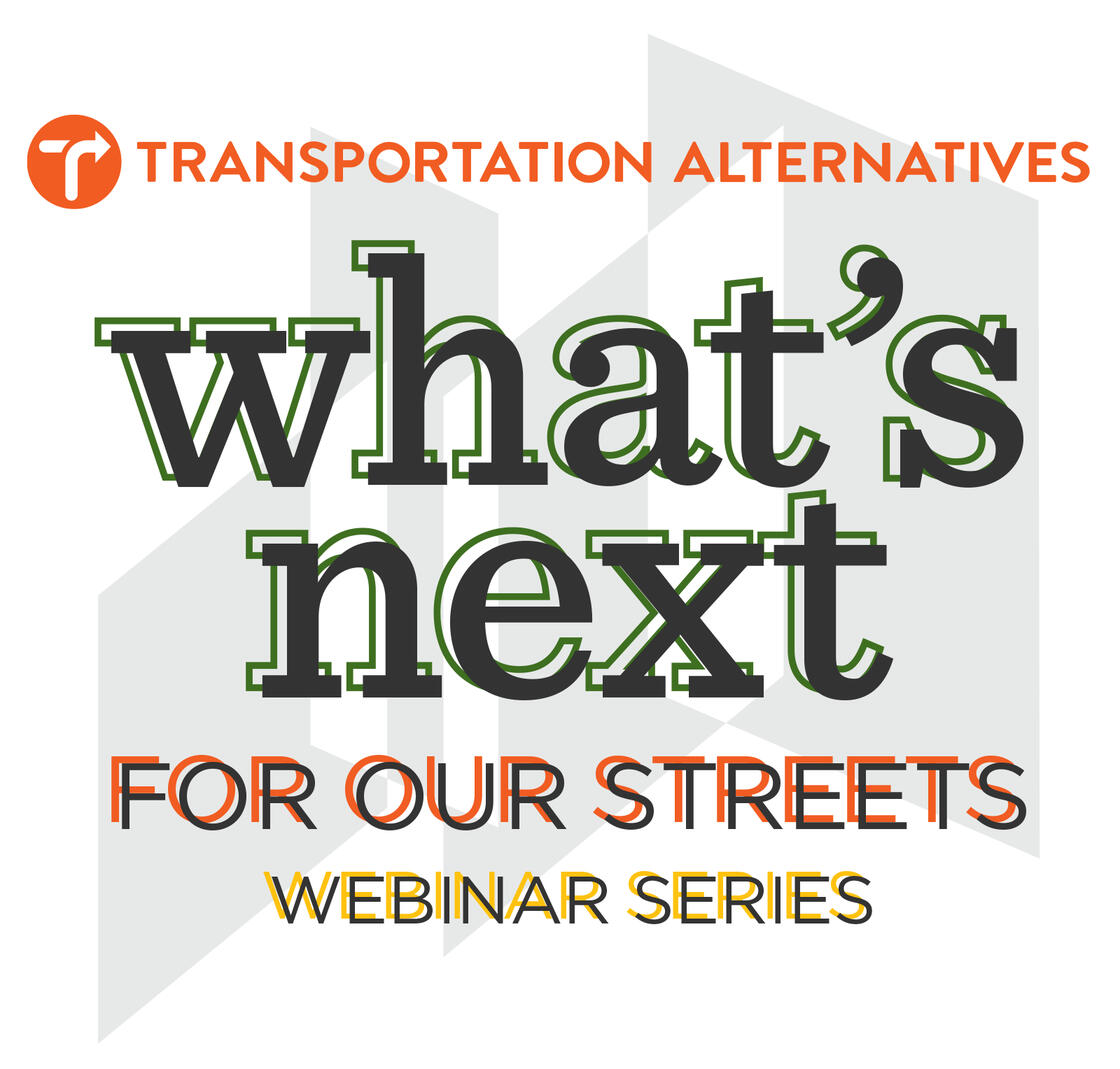
Join Transportation Alternatives for a series of conversations on what's next for our streets. We asked leading transportation, mobility, and urbanism experts what they think will shape our cities' futures in the wake of the coronavirus pandemic, and how we can act now to ensure a more equitable future.
Watch Previous Sessions of
What's Next for Our Streets:
#BikeMatch:
Hear from organizers who started a nationwide grassroots movement to get bikes in the hands of our essential workforce, and what BikeMatch teaches us about the future of urban crisis mobility.
Moderated by:
Danny Harris, Executive Director, Transportation Alternatives
Intro with:
J Oberman, Art Director, Transportation Alternatives
Panel:
Ian Kenny, Leader Global Marketing, Specialized
Rachel Maisler, Founder & CEO, Wonk Policy & Communications
Kevin Shin, Senior Director, Policy and Partnerships, Los Angeles County Bicycle Coalition
Key Takeaways
The #BikeBoom has been seen in a huge demand for bikes, for commuters and for kids, families, and leisure riding.Significantly, in a time of limited transportation options, bikes have allowed essential workers to safely get to their jobs, and have become a foundational support mechanism in communities around the world. Transportation Alternatives began #BikeMatch to connect these workers with used bikes donated by the community, and the program has spread to 26 other cities.#BikeMatch programs have been adapted to local contexts through new technologies, partnerships with bike shops and nonprofits and with virtual bicycling education programs.The programs were boosted by both in-group media exposure and general media coverage, as well as more targeted contact to small communities.There is an opportunity for bicycles to facilitate our cities’ economic recovery by allowing access to local businesses, promoting goodwill towards cycling and bike infrastructure in neighborhoods that may not understand their potential.
Micromobility
Learn about how the micromobility movement has reacted to COVID-19, and the ways in which our cities must think creatively about mobility in the post-pandemic future.
Moderated by:
Danny Harris, Executive Director, Transportation Alternatives
Panel:
Frank Reig, CEO, Revel
Georgia Yexley, Head of Growth, Beryl
Nora Kern, Executive Director, Walk Bike Nashville
Key Takeaways
During the pandemic, providing free or discounted transportation options to essential workers -- particularly with all-hours and citywide access -- has led to a surge in ridership and helped bring typically underserved communities into the bike and micromobility world. Increased representation in turn normalizes these modes as pragmatic and accessible options.Micromobility works best when issues of equity, access, and safety are prioritized from the beginning, and space is taken from cars, not pedestrians. Corralling scooter and bikeshare systems into bays leaves sufficient sidewalk space for pedestrian use. Increased bike and scooter use amplifies the need for more safe infrastructure.Responsive governments might require equitable distribution of and access to micromobility, fund initiatives to increase their use, and incentivize these choices by making them the easiest option.Micromobility companies should engage in regular and broad conversations with local communities and authorities about equitable implementation, and integrate equity into all aspects of the system.
In Partnership With:
E-Bikes & Working Cyclists
Join the conversation about how e-bikes have the potential to remake urban mobility, and what impact they can have on our recovering urban economies.
Moderated by:
Marco Conner DiAquoi, Deputy Director, Transportation Alternatives
Panel:
Senator Jessica Ramos, New York State Senate, Chair of Committee on Labor
Dr. Do Lee, Professor, City University of New York
Denzel Singletary, Senior Manager of Government Relations, Postmates
Key Takeaways
E-bikes were not fully legalized in New York until this year, and remain illegal in many other states. Here in New York City, there are now three classes of legal e-bikes, including a max-25mph throttle e-bike common among NYC’s 30,000+ delivery workers.Delivery workers are generally low-income people of color, often immigrants, who begin because of the low barrier to entry. While they have traditionally been overlooked as an essential component of the city, the pandemic has brought light to their role as frontline workers, putting food on New Yorkers’ tables and providing business to local restaurants.Delivery workers have been disproportionately targeted by the NYPD for riding e-bikes. They often haven’t reported assaults and robberies to the police for fear of their e-bikes might be seized, drawing attention to an undocumented status, and disproportionate targeting.Politicians, advocates, and companies are fighting for general workers’ rights for delivery workers, including the rights to collective bargaining, workers’ compensation, and unemployment benefits. These efforts face challenges in the media’s tendency to exclude workers’ voices and many delivery companies’ prioritization of the bottom line. Future efforts should make sure that all parties are at the table and understand that it is in all of their interests.
Open Streets
Join a conversation about the international movement to reclaim street space from cars. Hear how today's push for Open Streets can make our cities greener, safer, and more equitable for future generations.
Moderated by:
Danny Harris, Executive Director, Transportation Alternatives
Panel
Meera Joshi, Principal + New York General Manager, Sam Schwartz
Mike Lydon, Principal, Street Plans
Shabazz Stuart, CEO, Oonee
Key Takeaways
For many, streets open to people have shifted in meaning from open fire hydrants and block parties, to space for safe movement and social distancing, to space for demonstrations and social change. In each iteration, they serve as a public place for community gatherings and civic life without significant funding and government planning.Cities with the most successful Open Streets programs have built trust and collaboration between advocacy and community groups and committed elected officials. These programs view the streets as an interconnected network for safe movement, have thought through their future use and relevance, and have prioritized fast implementation and equitable distribution.To create equitable access to Open Streets, planners have to be proactive, not reactive. They must pay attention to who is not being represented, reaching out to hear their perspectives, adapting streets to their needs, and including them in larger coalitions.Enforcement should be used minimally and only to keep streets safe. Visual cues, like painted streets, friendly barriers, and activities in the streets, can indicate the streets’ purpose without a police presence, and community public safety officers or ambassadors can maintain and monitor the space.Open Streets should be grounded in objectives and principles -- with equity and inclusion at the forefront -- that extend beyond current emergencies so their relevance and rationale won’t expire in the fall. Measures to quantify their effects in reaching these objectives should be gathered to use as an argument for future calls for a return to ‘normal’ streets.

